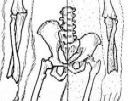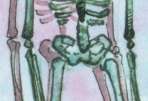

Parker's book consists of an enormous amount of misdirection, and evasion of most of the best evidence for human evolution. All the old creationist favorites such as Piltdown Man, Nebraska Man, Ramapithecus and Nutcracker Man are discussed. Of course, these have little or no relevance to the modern study of human evolution, and some of them never did.
Piltdown Man is a famous fossil fraud which was accepted as legitimate for decades. It adversely affected the study of human evolution for decades, but by the time Skeletons was published the hoax had been exposed for 45 years. Nebraska Man, however, was never widely believed to be a human ancestor and had no impact on the study of human evolution prior to its correct identification only a few years after its discovery. Ramapithecus is a fossil ape which, between about 1960 and 1975, was often considered a human ancestor on the basis of some overenthusiastic speculation, but has not been important in human evolution since then.
Parker spends a couple of pages discussing the 'Zinjanthropus' or 'Nutcracker Man' fossil. This is a legitimate fossil, the skull of a robust australopithecine, named OH 5, discovered in 1959 by Louis and Mary Leakey. Parker implies most scientists believed that OH 5 was a human ancestor and a tool user, and did so until 1972 when Richard Leakey found modern human bones buried at a deeper level.
In fact, Louis Leakey was the only scientist to ever seriously entertain the idea that OH 5 was a human ancestor - to most other scientists, it seemed obvious that it was some sort of robust australopithecine. And even Leakey quickly abandoned the idea, because less than a year and a half later he discovered other hominid bones (OH 7, now allocated to Homo habilis) below OH 5. The 'modern human bones' discovered by Richard Leakey aren't modern human bones, and were actually discovered at another site far away.
Parker mentions three other "huge mistakes": an alligator bone, a horse's toe bone, and a dolphin rib, all supposedly misidentified as hominids. The first two of these are so obscure that I have never been able to find out the details about these fossils or who misidentified them. Whatever they were, they are irrelevant - they were never accepted or even named as hominid species, and sank without a trace.
As for the dolphin's rib, it's almost as irrelevant. Parker says that "... the evolutionist who found it thought he could prove it was an ape-man who walked upright!" but the truth is somewhat different. The scientist who found the fossil spent considerable effort trying to identify it, and finally decided that it was probably hominid, but other scientists at a conference identified it as a dolphin's rib. It too was never named as a hominid, and its discoverer never claimed he could prove it walked upright - that detail was just invented by Parker. [1]
In contrast to the space devoted to these irrelevancies, legitimate fossils are either ignored or misrepresented.
Homo erectus barely gets mentioned, and only in connection with the Java Man and Turkana Boy erectus fossils. The Turkana Boy is claimed, wrongly, to be identical to modern humans, and Java Man is waved away as a mistake (Parker apparently believes that the Java Man skullcap belongs to an ape), in spite of the fact that the skulls of these two fossils are very similar. The fact that dozens of erectus fossils exist and that their skull anatomy in particular is quite different from modern humans is concealed. Readers could easily get the impression from Parker that the species of Homo erectus doesn't even exist.
Homo habilis, one of the most important species in human evolution, never even gets mentioned. (Many creationists now claim that habilis isn't a valid species, but that isn't true.) One habiline skull is mentioned indirectly (ER 1470, on p. 37) but its bones are wrongly claimed to be "like those of modern man".
Irritatingly, Parker gives no references for most of his important claims. There are only 8 references in the whole book, mostly for unimportant points, and all but one of them refer to other creationist sources. I wrote to Parker twice, asking him for references for many of his claims, including most of the points listed below. I never received any reply.
Here are a number of the more questionable claims from the book:
Parker says that Dubois "didn't tell anyone for over thirty years about the human [Wadjak] skulls he discovered". This is also false; in fact Dubois published three articles mentioning the Wadjak skulls soon after their discovery.
Parker says that "At least Dubois finally told the truth, and no informed scientist calls the Java mistake an ape-man anymore." What do they call it then? Parker doesn't say, but this sounds like a rehash of the old creationist canard that Dubois eventually decided that the Java Man skullcap was just a giant gibbon and nothing to do with human evolution. Wrong again; Dubois never abandoned his claim that Java Man was a human ancestor. This discredited claim has been abandoned even by Answers in Genesis, who include it in their list of Arguments we think creationists should NOT use.
"Mom: ...But other scientists didn't just look [at Lucy]; they took measurements.As far as I can tell, this is complete fiction. I have never heard of any scientific papers claiming that Lucy did not walk upright. I can only imagine that Parker has some muddled memory of a well known paper by Charles Oxnard (1975), in which Oxnard claimed some functional similarities between some australopithecine bones and orang-utans. However, Oxnard was examining South African specimens of A. africanus, not Lucy (which is in A. afarensis). And, Oxnard did not say that A. africanus could not have walked upright.
Dana: What did the measurements show?
Mom: They showed that Lucy did not walk upright. In fact, another ape, an orangutan, would have walked more like a person than Lucy could."

The similarity as depicted in Zihlman (1984) with chimp on left, Lucy on right |

The similarity as depicted by Parker |
Except for having small rather than large teeth, and a quadrupedal rather than a bipedal pelvis, pygmy chimpanzees are remarkably like early gracile australopithecines in their skeletal dimensions.
An unpleasant aspect of the book is Parker's continual denigration of scientists, in both word and picture. A few cartoons depict scientists as either overweight or scrawny (but always unattractive), and foolish or dishonest. This is pretty rich, coming from someone with Parker's carelessness with the truth. Here are a couple of examples:

The discoverer of 'Nebraska Man', daydreaming about his find. |

This scientist has a bubble saying "These bones obviously belong to a female 'ape-woman' with an I.Q. of 47 who was carrying one of her 3 children as she walked upright." |
Accompanying Parker's claims about the Wadjak skulls (discussed above) is an illustration showing a masked man under cover of night putting a human skull into a box labelled "Evidence to hide - Man before Ape-man".
Later he claims that Donald Johanson deliberately and fraudulently altered the pelvis of Lucy to make it look as though she was bipedal. This is based on the first episode of the NOVA series In Search of Human Origins, where Johanson does make statements that could, for those of a conspiratorial turn of mind, be interpreted as an admission of having doctored the bones. Reading the transcript carefully, however, it is clear that the bones had been originally been broken and the pieces fused together during fossilization. As scientist Owen Lovejoy explained on the show, the bones were originally in an 'anatomically impossible position', so he broke a cast of the fossil (not the original!) in an attempt to reverse the damage which occurred during fossilization. (For more information see: Creationist Claims About the Reconstruction of the "Lucy" Pelvis)
Elsewhere, one of the Parker children asks rhetorically whether museum displays aren't being dishonest in displaying fossils such as Java Man and Nutcracker Man. Indeed they would be if the fossils were being misrepresented, but there's no evidence that that is the case. Java Man is correctly classified as Homo erectus in museums, and Nutcracker Man as a robust australopithecine not ancestral to humans. If Parker has any reasons to claim these aren't correct identifications, he should state them rather than casting slurs on the honesty of museums.
Parker, like many creationists, can't resist the urge to smear evolution with the racism tag, and brings up cases where scientists have claimed that aboriginals or Negroes were subhuman. Such cases do exist, though it's impossible to evaluate Parker's examples because of the lack of references. I suspect, however, that these cases are aberrations of individual scientists and that the claims were not the standard scientific thinking in their day. And, of course, Parker doesn't mention that creationist scientists both before and after Darwin were often equally racist. [2]
Referring to the Tasmanian genocide, Parker says "The settlers believed so strongly that the Tasmanian natives were part animal that they formed a human chain across parts of the island to hunt down and kill all the native peoples." [3] Although he is obviously trying to pin the blame for this on evolution, it occurred in 1830 - some thirty years before Darwin published his theory. The settlers were not evolutionists, but were mostly Christians - maybe Parker should reconsider his belief that evolution is responsible for racism.
Although Parker brags about his scientific credentials (and even once says, nauseatingly, that "...I'm a scientist who spends a lot of time studying fossils. It's my business to know things like that") there is no evidence from this book that he has any first-hand knowledge of the scientific literature on human evolution. As far as I could tell, all of the material in Parker's book could have been recycled from other creationist sources, and probably was; it is hard to see how someone familiar with the scientific literature could get so much wrong. I doubt that he was even paying much attention to his creationist sources - Parker is so sloppy with his facts that I suspect he was often working from memory.
I'll admit that I did not come to this book expecting to be impressed by it. Still, I was surprised at how appallingly bad it was. Parker is, after all, an important figure in the world of creationism (see his bio here). He was prominent in the Institute for Creation Research for many years, and then founded Answers in Genesis along with Ken Ham. He has legitimate qualifications including a doctorate in science education. And yet often he seems unaware even of what fellow creationists are saying about human evolution, let alone real scientists. Parker's book is an example of the worst of creationist literature, a shoddy collection of recycled misinformation.
This book not only contains no reliable scientific information, but is dishonest to the core as well as being blisteringly incompetent. Any kid who relied on Skeletons in your Closet wouldn't have a hope of being able to participate in a discussion of human evolution, and wouldn't even be able to understand the discussion. Even creationists should be embarrassed by this book. [4]
1. The discoverer of the dolphin rib was Noel Boaz. You can read more about this incident in Boaz's book Quarry, and in Lucy's Child by Johanson and Shreeve. Return to text
2. For example, the virulently racist creationist Louis Agassiz, as described by Stephen Gould in his book The Panda's Thumb. Darwin, by contrast, was remarkably non-racist for his time and a passionate opponent of slavery. Return to text
3. Actually, the purpose of the "Black Line" was not to kill the remaining aborigines, but to capture them. Return to text
4.
Though they apparently aren't. Both Answers in Genesis and the Institute for Creation Science sell Skeletons, with ICR calling it a "landmark book".
[Update Sep 2008: Hmm, it now appears to have disappeared from ICR's catalogue. AIG still has it, but with a "... this item is no longer available" banner.]
[Update May 2011: Now it appears to have disappeared from AIG's catalogue too. Maybe they were embarrassed by it.] Return to text
Oxnard C. (1975): The place of the australopithecines in human evolution: grounds for doubt? Nature, 258:389-95.
Zihlman A.L. (1984): Pygmy chimps, people, and the pundits. New Scientist, (15 November 1984)39-40.
This page is part of the Fossil Hominids FAQ at the talk.origins Archive.
Home Page |
Species |
Fossils |
Creationism |
Reading |
References
Illustrations |
What's New |
Feedback |
Search |
Links |
Fiction
http://www.talkorigins.org/faqs/homs/closet.html, 09/30/2004
Copyright © Jim Foley
|| Email me 